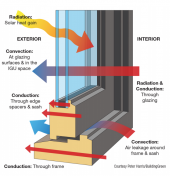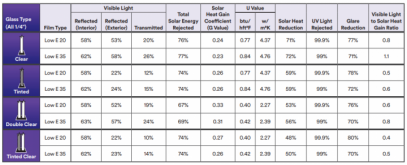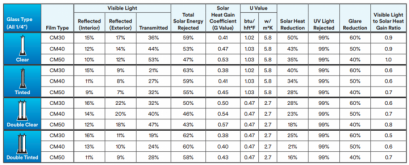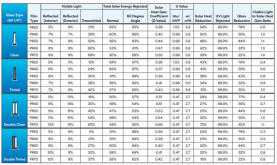From the
EPA Carbon Footprint calculator, energy-efficient windows can reduce my carbon footprint by > 4 tons per year....that's enough to offset the carbon emissions from my car doing 12k miles a year.
But only a few windows catch the morning sun, all the other windows
are usually in the shade.
Could it really save that?
What makes an energy-efficient window / door?
There's more here, but in general, it's a multiple pane window to reduce
convection, frames that reduce conductive heat loss, and a film to
block/reflect high energy UV and frequencies.
AFAIK, a window film generally only addresses the radiation.
Unlike most of the world, it doesn't generally get cold here, the
average temperature difference between inside and outside is < 12°F
in summer and there aren't enough cold days to matter.
How much AC must I provide for them?
Conduction is Heat/Time = k/d A(Thot - Tcold) where k is the thermal
conductivity of the material (0.96 W/m/h/°C or 0.169179 BTU/ft/h/F)
for glass) and d is the thickness of the barrier. |  |
When I lived in Colorado with a winter temp of -10°F then the temperature driver is (22- (-23) =45, 9x higher than it is here for summer. So, a lot of the EPA savings is probably around winter temperatures.
The more common way for windows is with the R-Value. A 1/4" glass window has an R-value of .90, a double-paned window 1.7.
Heat loss/gain = area (ft²) ΔT (°F)/ R-Value. To meet EnergyStar there must be an R-Value no less than 1.56.
My windows are "safety glass", which is two sheets of 1/16th inch glass with a PVB laminate center (0.12 BTU/ft² h °F). So, how much heat am I gaining through them in summer? As there are three layers you can solve it with some calculous, or cheat and look and look it up on their datasheet. For me, it's an R-Value of 1.1. So, per square foot of window and 13°F ΔT that's 11.8 BTUs/hr/ft². So, if I had 400 ft² of windows, that would be ~4700 BTU/hr heat gain. A 60 watt incandescent light bulb generates 204.72 BTU/h, so that/s about 23 light bulbs.
But, with energy star windows at 1.56, I'd have 8.3 BTUs/hr/ft² heat loss, or for 400 ft² would be 3333 BTU/hr. So, it would only save~1400 BTU/hr, or the heat from < 7 sixty watt light bulbs.
So, probably not worth it for me. I suspect most of my energy losses are from air leaks and doors being left open that lets gallons of water in the form of humidity enter the house that the AC needs to remove. Wonder if an "air-lock" type entrance would make a difference?
So, not much incoming solar radiation for me means window films aren't worth it and the low return on replacing the windows means it isn't worth it.
But if you live in cold climates, I can easily see how it might be worth it.
For example, that -10°F in Colorado, for 1/4" glass windows that's 78/.9 x 400 = 34,666 BTU/hr loss for the same 400 ft² of windows.
Brrr!






